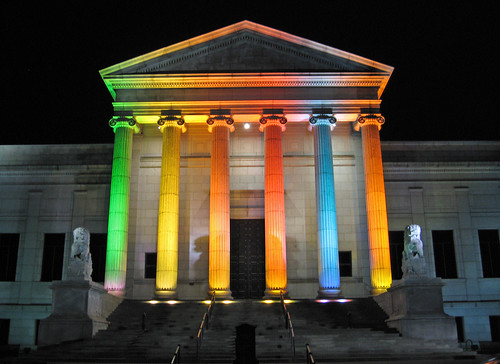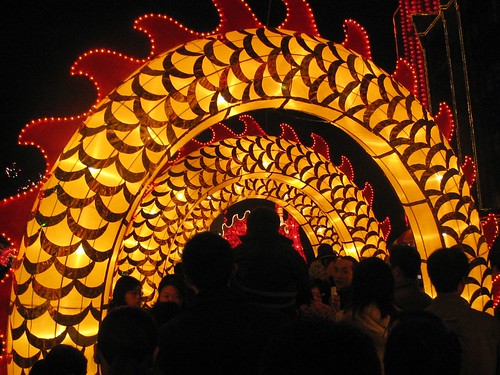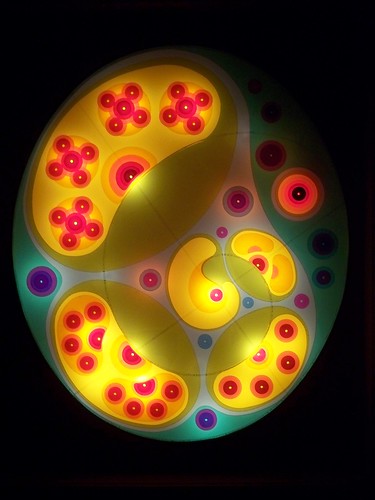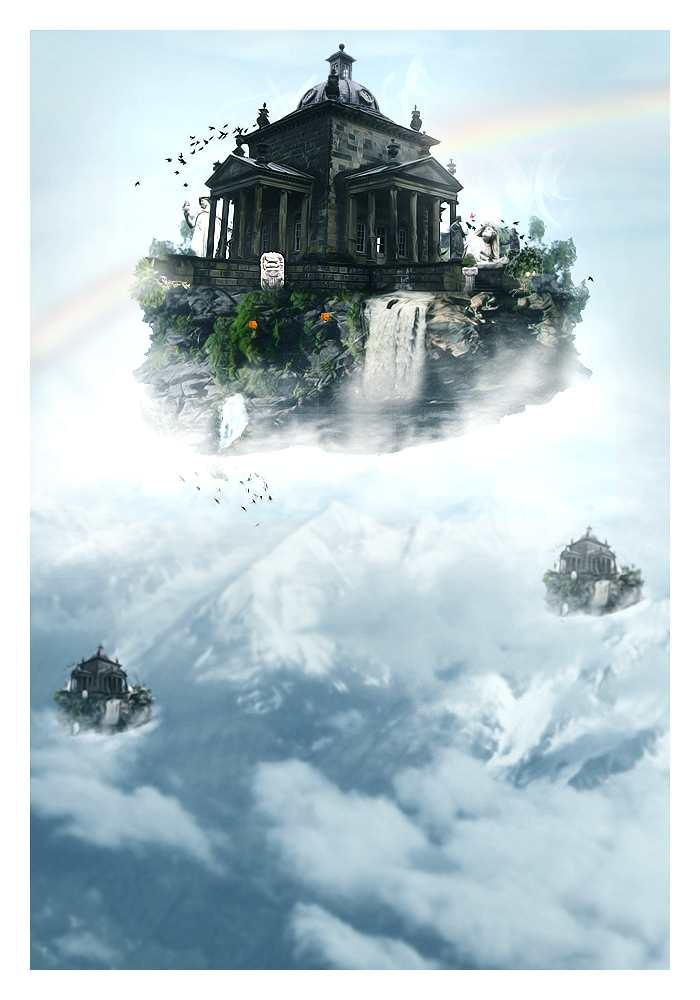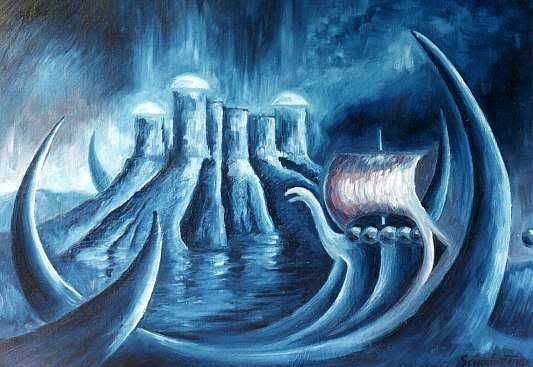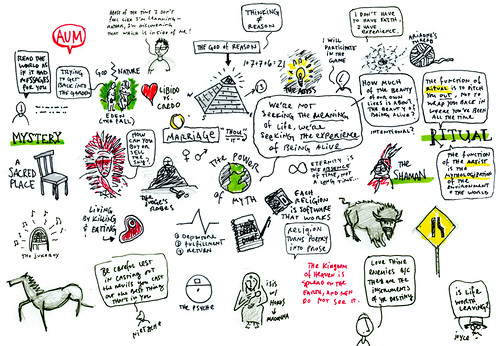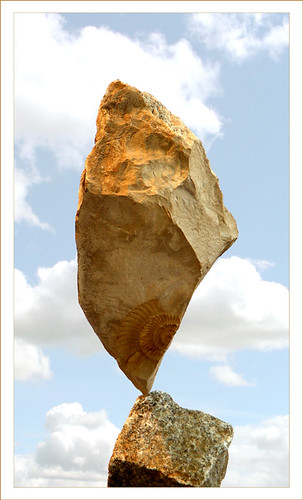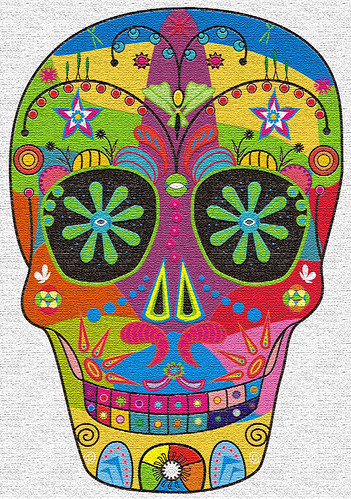presents two views regarding Asgard.
Prologue
In the Prologue Snorri offers an
euhemerized and Christian-influenced interpretation of the myths and tales of his forefathers. As-gard, he conjectures, is the home of the Æsir (singular Ás) in As-ia, making a
folk etymological connection between the three "As-"; that is, the Æsir were "men of Asia", not gods, who moved from Asia to the north and some of which intermarried with the peoples already there. Snorri's interpretation of the 13th century foreshadows 20th century views of
Indo-European migration from the east.
Snorri further writes that Asgard is a land more fertile than any other, blessed also with a great abundance of gold and jewels. Correspondingly, the Æsir excelled beyond all other people in strength, beauty and talent.
Snorri proposes the location of Asgard as
Troy, the center of the earth. About it were 12 kingdoms and 12 chiefs. One of them, Múnón, married
Priam's daughter, Tróán, and had by her a son, Trór, to be pronounced
Thor in
Old Norse. The latter was raised in
Thrace. At age 12 he was whiter than ivory, had hair lighter than gold, and could lift 10 bear skins at once. He explored far and wide. His son, Odin, led a migration to the northern lands, where they took wives and had many children, populating the entire north with Aesir. One of the sons of Odin was
Yngvi, founder of the
Ynglingar, an early royal family of
Sweden.
In
Gylfaginning, Snorri presents the mythological version taken no doubt from his sources. Icelanders were still being converted at that time. He could not present the myths as part of any current belief. Instead he resorts to a debunking device: Gylfi, king of Sweden before the Æsir, travels to Asgard and finds there a large hall (
Valhalla) in Section 2.
Within are three officials, whom Gylfi in the guise of Gangleri is allowed to question about the Asgard and the Æsir. A revelation of the ancient myths follows, but at the end the palace and the people disappear in a clap of thunder and Gylfi finds himself alone on the plain, having been deluded (Section 59).
In Gylfi's delusion, ancient Asgard was ruled by the senior god, the all-father, who had twelve names. He was the ruler of everything and the creator of heaven and earth (Section 3). During a complex creation myth in which the cosmic cow licked
Buri free from the ice, the sons of Buri's son,
Bor, who were
Odin,
Vili and Vé, constructed the universe and put
Midgard in it as a residence for the first human couple,
Ask and Embla, whom they created from driftwood trees in Section 9.
Consistency is not to be expected from the myth. The sons of Bor then constructed Asgard (to be identified with Troy, Snorri insists in section 9) as a home for the Æsir, who were divinities. Odin is identified as the all-father. Asgard is conceived as being on the earth. A rainbow bridge,
Bifröst, connects it to heaven (Section 13). In Asgard also is a temple for the 12 gods,
Gladsheim, and another for the 12 goddesses,
Vingólf. The plain of
Idavoll is the centre of Asgard (Section 14).
The gods hold court there every day at the
Well of Urd, beneath an ash tree,
Yggdrasil, debating the fates of men and gods. The more immediate destinies of men are assigned by the
Norns (Section 15).
Long descriptions of the gods follow. Among the more memorable details are the
Valkyries, the battle maidens whom Odin sends to allot death or victory to soldiers. Section 37 names 13 Valkyries and states that the source as the Poetic Edda poem
Grímnismál. Odin's residence is
Valhalla, to which he takes those slain in battle, the
Einherjar (Section 20). Snorri quips: "There is a huge crowd there, and there will be many more still ...." (Section 39). They amuse themselves every day by fighting each other and then going to drink in the big hall.
Toward the end of the chapter Snorri becomes prophetic, describing
Ragnarök, the twilight of the gods. Much of it sounds like the
Apocalypse, by which Snorri, a Christian, can hardly fail to have been influenced. It will begin with three winters of snow, with no summers in between. Wars will follow, then earthquakes and tidal waves. The sky will split open and out will ride the sons of
Muspell intent on universal destruction. They will try to enter heaven but Bifröst will break (Section 55).
Heimdall will blow his mighty horn Gjöll and the Æsir and Einherjar will ride out to battle. Most of the Æsir will die and Asgard be destroyed. Snorri quotes his own source saying: "The sun will go black, earth sink in the sea, heaven be stripped of its bright stars;...." (Section 56).
Afterwards, the earth rises again from the sea, is fairer than before, and where Asgard used to be a remnant of the Æsir gather, some coming up from
Hel, and talk and play chess all day with the golden chessmen of the ancient Æsir, which they find in the grass (Section 58).
Skáldskaparmál
The 10th century Skald
Þorbjörn dísarskáld is quoted in
Skáldskaparmál as stating:
"Thor has defended Asgard and
Ygg's [Odin's] people [the gods] with strength."
Heimskringla
Ynglinga Saga
By the time of the
Ynglinga Saga, Snorri had developed his concept of Asgard further, although the differences might be accounted for by his sources. In the initial stanzas of the poem Asagarth is the capital of Asaland, a section of Asia to the east of the Tana-kvísl or Vana-Kvísl river (kvísl is "fork"), which Snorri explains is the
Tanais, or
Don River, flowing into the
Black Sea. The river divides "Sweden the Great", a concession to the
Viking point of view. It is never called that prior to the Vikings (Section 1).
The river lands are occupied by the
Vanir and are called Vanaland or Vanaheim. It is unclear what people Snorri thinks the Vanes are, whether the proto-
Slavic Venedi or the east Germanic
Vandals, who had been in that region at that time for well over 1000 years. He does not say; however, the Germanic names of the characters, such as Njord, Frey and Vanlandi, indicate he had the Vandals in mind.
Odin is the chief of Asagarth. From there he conducts and dispatches military expeditions to all parts of the world. He has the virtue of never losing a battle (Section 2). When he is away, his two brothers,
Vili and Vé, rule Asaland from Asagarth.
On the border of Sweden is a mountain range running from northeast to southwest. South of it are the lands of the Turks, where Odin had possessions; thus, the mountains must be the
Caucasus Mountains. On the north are the unihabitable fells, which must be the tundra/taiga country. Apparently the Vikings did not encounter the
Urals or the
Uralics of the region. Snorri evidences no knowledge of them.
There also is no mention of
Troy, which was not far from
Constantinople, capital of the
Byzantine empire and militarily beyond the reach of the Vikings. Troy cannot have been Asagarth, Snorri realizes, the reason being that the Æsir in Asaland were unsettled by the military activities of the Romans; that is, of the Byzantine Empire.
As a result, Odin led a section of the Æsir to the north looking for new lands in which to settle. They used the Viking route up the Don and the
Volga through
Garðaríki, Viking
Russia. From there they went to Saxland (Germany) and to the lands of
Gylfi in
Scandinavia (Section 5). The historical view, of course, is mainly fantastical. The Germanics were in Germany and Scandinavia during earliest mention of them in Roman literature, long before the Romans had even conquered Italy. To what extent Snorri's presentation is poetic creation only remains unclear.
Demoted from his position as all-father, or king of the gods, Odin becomes a great sorcerer in the Ynglinga Saga. He can shape-shift, speaks only in verse, and lies so well that everything he says seems true. He strikes enemies blind and deaf but when his own men fight they go berserk and cannot be harmed. He has a ship that can be rolled up like a tablecloth when not used, he relies on two talking ravens to gather intelligence, and he consults the talking head of a dwarf for prophecy (he carries it around long since detached from its body) (Section 7).
As a man, however, Odin is faced with the necessity to die. He is cremated and his possessions are burned with him so that he can ascend to - where? If Asgard is an earthly place, not there. Snorri says at first it is Valhalla and then adds: "The Swedes now believed that he had gone to the old Asagarth and would live there forever" (Section 9). Finally Snorri resorts to Heaven, even though nothing in Christianity advocates cremation and certainly the burning of possessions avails the Christian nothing.



